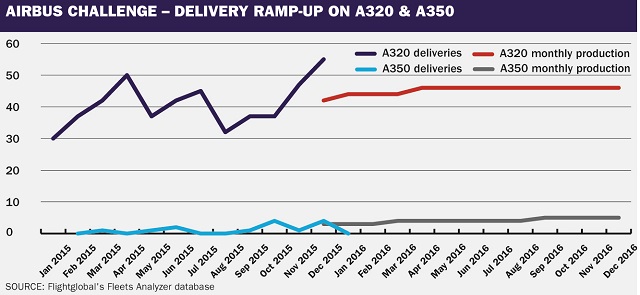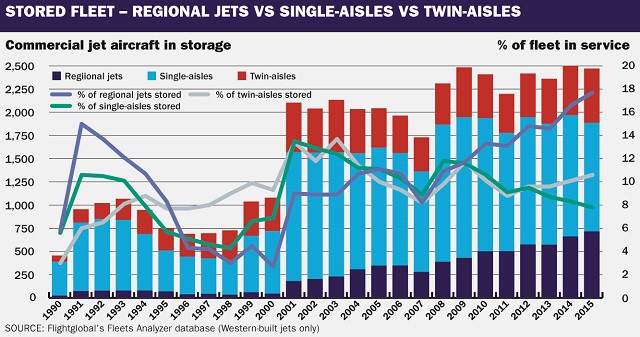Richard Evans, senior consultant with Flightglobal’s advisory arm Ascend, here shares some of the indicators and issues the team will be keeping a close eye on as 2016 wears on – and explains what they may mean for the health of the industry
As we move through the early months of 2016, it appears this year will be as interesting as always for the commercial aircraft market. Macroeconomic uncertainties are ever-present, the airline industry is making serious money, and financiers, lessors and OEMs are bullish. New airline products are entering service, and production is ramping up.
Ultimately, airlines and suppliers to the industry rely on travel demand from passengers. We saw monthly year-on-year growth above 6% in all but two months of 2015. In the peak summer season, passenger traffic as measured in RPKs grew by at least 7%. The long-run average is around 5%. Strong demand has boosted airline finances and helped underpin the wave of new deliveries scheduled for this and subsequent years. We will be looking at the growth rate closely over the coming months. If it falls towards or below the 5% figure, this may herald overcapacity, given the bullish capacity plans of many airlines.
The quality of the growth is also important. In other words, is it driven by a strong global economy, or is it driven by ticket price falls and yield reduction? At present, we are seeing huge year-on-year reductions in jet fuel prices, which means yield reductions of 5-10% do not mean airlines will necessarily make losses. Therefore it is necessary to look at the balance between unit revenue changes and unit cost changes. Airlines for America (A4A) publishes monthly yield data, but unit costs are more difficult to monitor in a timely manner. One indicator to keep an eye on is business confidence. Businesses are the main drivers of premium ticket sales, as well as major investors in infrastructure, equipment and services. Thus business confidence can be a good predictor of airline fortunes.
Moving on to fleet metrics, stored aircraft numbers provide another indicator of supply and demand. The absolute quantity of parked aircraft recorded in Flightglobal's Fleets Analyzer database is less important than the percentage of the overall fleet that is parked. If an individual aircraft type has a high stored percentage, this indicates that aftermarket revenues will be pressured and values will fall, but if the overall percentage across the fleet increases, it can indicate too much supply generally and we should be concerned. At present, the proportion of stored single-aisles continues to decline, to around 8% of the fleet. If numbers stay at these levels, it will indicate continued strong demand. In contrast, twin-aisles have seen an increase over the past three years, to 11% stored. This is already a potentially concerning level and it there is any further increase in idle twin-aisle inventory, owners and investors with those assets may have cause to worry.

On a regional basis, airline load factors are usually cited as a good measure. Many airlines are planning on expansion this year, including very large numbers of new routes.
While this is perhaps a sign of confidence, could it also signal that airlines have so many new aircraft being delivered that they are struggling to know where to fly them? The Gulf mega-carriers continue aggressive expansion, and any fall in load factors for this region might indicate more general difficulties in filling seats.
Ultimately, supply and demand show up in airline quarterly results. Operating margins reached record levels in 2015, and were above 10% at several major airlines, even in the winter. Airlines are still seeing falling fuel prices, so 2016 may be even better. We will look at Q2 and Q3 results from North American and European airlines, to see if they can maintain the stellar margins of summer 2015.

Regarding aircraft values, the fall in fuel prices has drawn some to conclude that older equipment must surely now be more attractive. Possibly, but airlines and leasing companies have contracts to take delivery of many shiny new planes. If they have too many, they are not going to park their new, low-maintenance aircraft, but the older ones that burn more fuel and consume more spare parts. However, if we see evidence of increasing lease rates or values for mid-life aircraft, that should be good news all round, although for now at least we can't say that we are seeing those signs. Conversely, we will keep an eye on any impairment charges in quarterly financial results, especially from lessors.
STRONG MARKET
The operating lessors' market share, expressed as a share of the in-service fleet, has plateaued in recent years, perhaps as a result of alternative cheap finance available to many airlines. Sales transaction data has also been flat, with numbers not yet exceeding pre-recession levels as a proportion of the growing fleet. If we see an increase in the number of portfolio sales, lessor IPOs or general sales activity, this would indicate a continued strong market. Another indicator to monitor will be the time taken to remarket distressed aircraft returned from Transaero or other airline defaults.
Lastly, we move on to the aircraft manufacturers themselves. Commercial jet deliveries moved to another record high in 2015 at over 1,500 shipments, and should exceed 1,600 in 2016. However, there are challenges.
At Airbus, the number of A320neos delivered will be watched, after the initial delay of several weeks. Airbus almost achieved its A350 promise of 15 aircraft in 2015, but 2016's increase to "at least 50" is not necessarily easy, with the introduction of several new customers and the resulting pressure faced by interiors suppliers.
At Boeing, a key metric will be the order intake for the current-generation 777. Boeing will marginally cut 777 production from 2017, but 2015's order intake of just 38 aircraft is not significant in the context of our estimate of 180 open 777 slots remaining to be sold through the production transition phase to the revamped 777X family. Unless 2016's figure is higher, it may signal a further production rate cut in 2017 or 2018. Some regional manufacturers also need to see more orders, in particular Bombardier for the CRJ family, but we have also seen very few regional jet orders outside the USA recently, and this is a finite market governed by scope clauses.

The year 2016 is a big one for new-entrant aircraft manufacturers. Mitsubishi will be hoping for a good year of flight testing on the MRJ, following the December 2015 disclosure of another one-year delay to 2018. Bombardier sounds much more positive about CSeries entry into service in mid-2016 with Swiss, but the lack of new orders is concerning. Irkut should fly the first MC-21 by the end of the year, as should Comac with the C919. Look out for dates slipping, although it would be nice to see an absence of further delays, as each one plays into the hands of Airbus, Boeing and Embraer.
Get all the latest news, analysis and opinions from Singapore Airshow on our dedicated show page
Source: Cirium Dashboard
















